While their behavior is not drastically different than those of any other regular bee, black bees mostly stand out due to their appearance and the sound they make.
Generally, the term black bee is used to describe various bee species that are dark in color, even though most of them have other shades of color as well.
Black bees are usually referred to as carpenter bees though not all black bees belong to this species. Leaf-cutting bees and mining bees are also considered black bees due to their dark color.
Below we analyze each of these three black bees species: their descriptions and physical characteristics; behavioral patterns; their benefits and their not so desirable qualities; as well as ways of managing them.
Species Of Bees That Are Black
1. Carpenter Bees
Carpenter bees (Xylocopa spp) resemble bumblebees, with the largest being more than an inch long. The males are golden-blond with black shades while the females are entirely black.
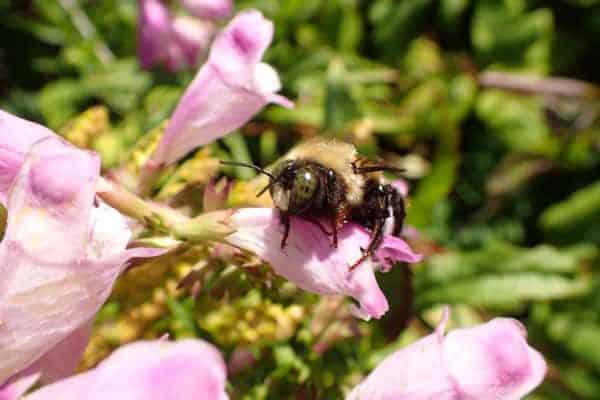
The males are often nicknamed “teddy bears” due to their soft, husky, and fuzzy look. Most bees are feared for their stinging ability. Carpenter bees’ huge, black and yellow body with a typical loud buzz could be frightening, but this fear is unwarranted in most cases. Especially considering the males don’t have a stinger.
Named for their incredible nesting behaviors, carpenter bees drill tunnels into wood.
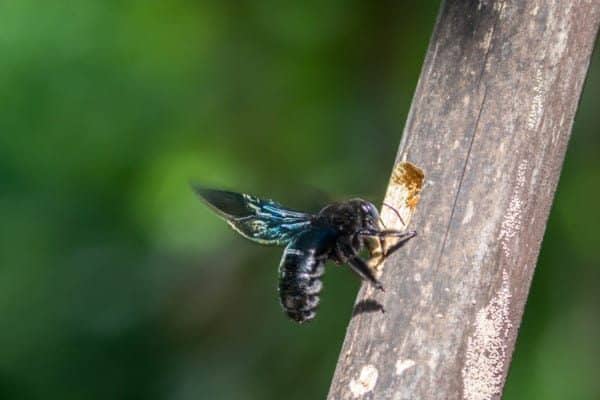
The males are very territorial and protect their nests, dashing at anyone or anything that comes close to their nest but are incapable of stinging, and occasionally hovering short distances away from an apparent threat. Despite having a seemingly aggressive habit, carpenter bees are in most cases gentle.
Though it might be hard to distinguish between carpenter and bumblebees as the species are similar, there are a few distinct features between them.
Bumblebee species are large with black and yellow marks on their bodies and are covered with hair all over. They are social insects, with colonies upwards of 40 members and one queen.
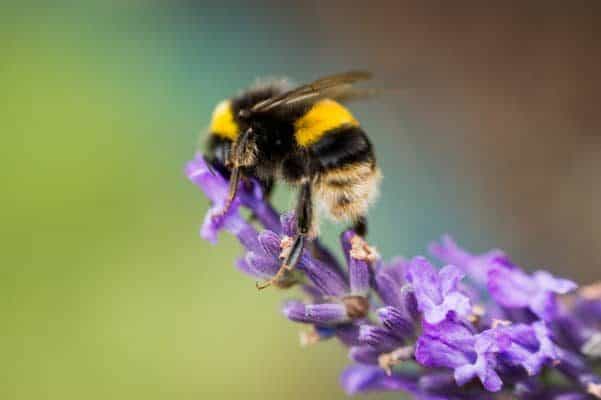
Bumblebees build underground nests and distribute their time between their nest duties and food foraging.
On the other hand, carpenter bees look like bumblebees both in coloring and size, with their abdomen’s upper part having little hair that ranges from shiny black to blue then green.
We have a detailed comparison article if you want to know more, Carpenter Bees Vs Bumblebees Vs Honey Bees.
The male carpenter bees have huge eyes for patrolling for possible mates and smaller heads that contain large pheromone reserves for attracting females depending on their species.
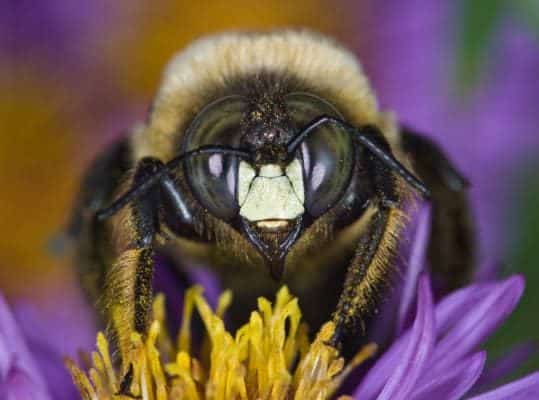
Carpenter bees are solitary; young bees that develop from the same nest separate as adults and only share a nest when mating.
While female carpenter bees administer a painful sting if deliberately provoked, their male counterparts, much like honey bees, do not have stingers.
Regardless of their “handy” name homeowners consider carpenter bees as troublesome due to their fondness for piercing and burrowing in wood. Drilling in wooden structures to build their nests is less than ideal if it ends up being a piece of furniture, or your home.
If you would like to know more about the dangers of carpenter bees to your property check out this article we have written, How Do Carpenter Bees Drill Holes? It’s Worse Than You Think
Carpenter bees are however more than just their nesting behaviors, the little black bees play an integral role in their local ecology, particularly in the pollination process.
For instance, roof eaves are usually unpainted on areas that face the house, which is invisible from the front side, making it a very attractive home for the carpenter bee to set up shop. However, their contribution to human and animal food security by pollination far outweighs any structural damage.
According to Bumblebee Conservation Trust (2020). Unlike the numerous carpenter bee species which damage wooden structures, some carpenter bees pick softer substrates to build nests such as old logs, pithy stems of plants, and untreated redwood.
These gentle bees do not intend to be pests – their behavior of nesting in siding, eaves, or decks made of wood frequently puts them at odds with homeowners. There are numerous effective ways of controlling the carpenter bee, with the most widespread measures being lethal to the bees.
There is a common misconception that carpenter bees eat wood, but they actually excavate it using their sharp strong mandibles, leaving sawdust deposits beneath their nest’s entrance. They have a preference for raw, unpainted, or old softwoods in particular cedar, pine, cypress, and redwood.
The female carpenter bees drill perfectly round holes (about half an inch) into pithy stems of plants and wood, typically against their grain alignment. The female turns at a right angle to drill along the grain of the wood after the tunnels reach about one inch deep. This angle provides the necessary protection for her larvae.
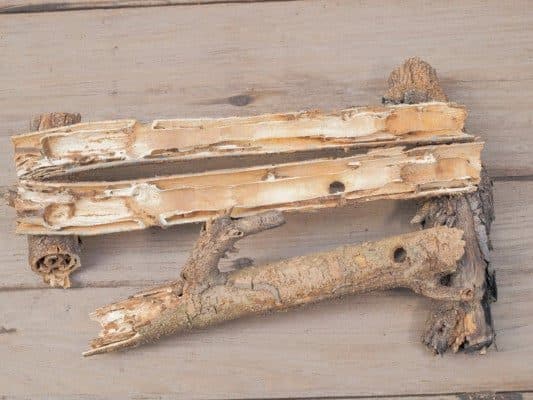
They repeat this process, drilling numerous chambers to form complex tunnel systems inside the wood. One tunnel alone can take the tiny bee up to 4 days to complete.
It is in these various chambers that the females lay their eggs. The females build partitioned brooding cells where they lay eggs and keep nectar and pollen. Adult carpenter bees emerge to the outer environment in summer, but as winter approaches, they look for abandoned tunnels to hibernate in there waiting for the cold season to pass.
The short parts of their mouth make carpenter bees crucial pollinators for shallow or open-faced flowers; and for others, like the passion flowers, these bees are their only existing pollinating agents.
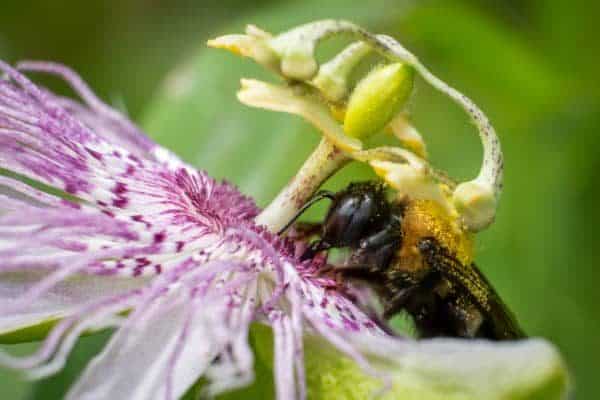
As they visit flowers foraging for nectar, pollen sticks on their hairy body and is then transferred to the next flower visited by the same bee. Human beings depend on insect pollination for almost 30 percent of their food, including nuts (almonds), fruits, vegetables, and seed crops.
Bees’ pollination contributes around $29 billion to the agricultural industry with around 15 percent of it being credited to native bees such as the carpenter bee (University of Minnesota, 2020). These pollinators are also relied on for wild plant pollination, which acts as food for birds and other wildlife animals.
The best way of preventing these unwanted house guests from nesting is by painting untreated woods or using vinyl or plastic sidings. Leaving old logs, rotten tree stumps, bamboos, or other pithy plants around homesteads can be an attractive alternative to carpenter bees, and can even help their population to thrive.
So, before getting a bottle of insecticide to control carpenter bees, or interfering with their nesting holes, homeowners should think again about their ecological benefits.
2. Leaf-cutting bee
Leaf-cutting bees (Megachile rotundata), also called chimney bees, are mostly moderate-sized (ranging from 5mm to 24mm), stout-bodied, and black.
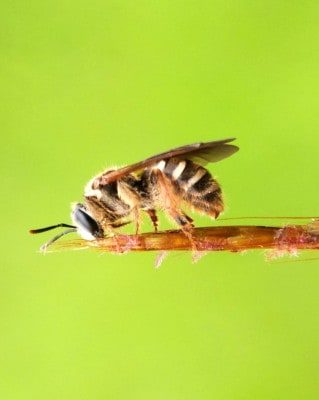
The females carry pollen grains on the hairs on their abdomen underside rather than on the back legs like other species of bees.
When they are carrying pollen, the abdomen’s underside appears light yellowish to deep golden color. Leaf-cutters are solitary bees and live in small groups or colonies.
Leaf-cutting bees, as their name indicates, use circular pieces of leaves (0.25 to 0.5 inches) they neatly cut from leaves to build their cigar-like nests that contain numerous cells. In each cell, a loaf or ball of pollen and an egg is stored. Therefore, each cell produces one bee.
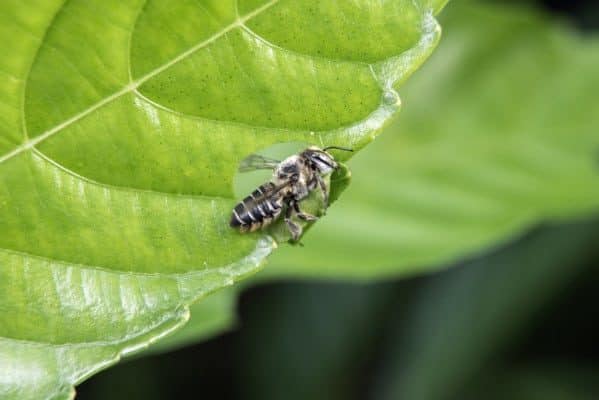
Leaf-cutting bees build the nests in holes (made by other insects), in soil, in woods, or in plant stems. In rare cases, a diversity of cavities, like shells, holes in concrete walls, and other man-made objects’ holes are used as nesting sites by these bees.
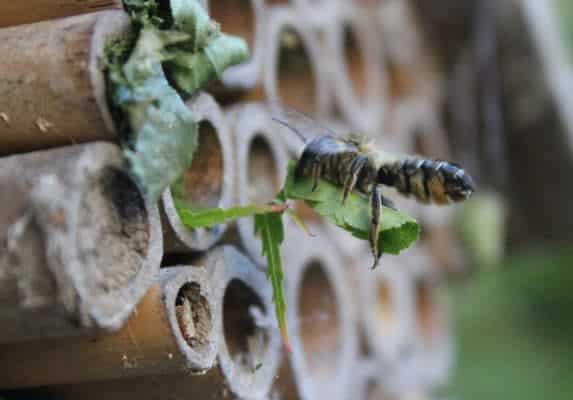
Most leaf-cutter bees hibernate in these nests in winter as newly formed adults. In the subsequent spring, these adult bees normally chew their way out of the nest.
Leafcutters do not defend nesting areas aggressively like bumble or honey bees. Their sting is said to be far less painful as compared to that of honey bees. Leaf-cutting bees only sting when handled and therefore pose no threat to people.
Leaf-cutting bees are key pollinators, particularly in North America for fruits, vegetable wildflowers, and have been used by commercial growers to pollinate onions, blueberries, alfalfa, and carrots. These bees use the leaves of almost all broadleaf deciduous plants for constructing their nests.
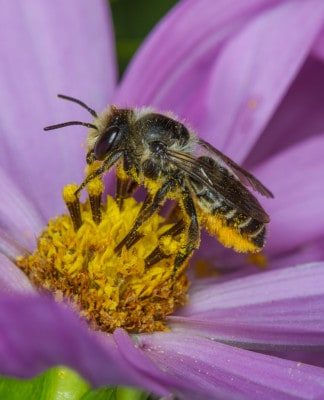
Some leaf-cutting bee species use resin and petals in addition to the leaves. These bees usually cut circles from ornamental vegetation such as roses, ash, azaleas, bougainvillea redbud, and other plants that have thin smooth leaves, hence decreasing their aesthetic value.
Leaf-cutting bees can only be considered pests due to their leaf-cutting behavior on ornamental plants. While the cutting could destroy the plant’s aesthetics, it rarely poses considerable harm.
Since leaf-cutting bees do not cut leaves for food, insecticides are normally ineffective in preventing leaf cutting. However, control of these bees may be done by placing physical barriers like cheesecloth or nets on susceptible plants to prevent damages. These barriers should however be used when the cutting is first observed.
3. Mining bee
Mining bees (Anthophora abrupta) are a group of around 450 native North American bee species that can also be classified as black (dark in color) (University of Minnesota, 2020).
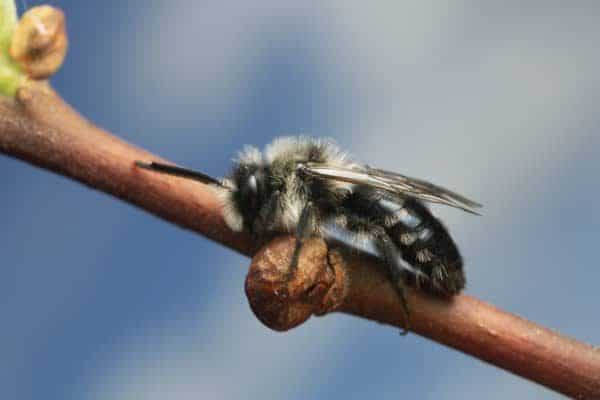
Superficially, an adult mining bee looks like a small bumblebee. The abdomens, legs, and heads are fully covered with dark brown to black hairs while their thoraxes are covered with dark, pale yellow to orange hairs.
Medium in size, these bees build their nests in the ground just like leaf-cutting bees. In most species, female mining bees have facial depressions. Their nests can be found in various places including gardens, around house foundations, under plant leaves, in sandy areas, and lawns. They are extremely docile bees that are active during the spring only.
As their naming indicates, mining bees dig tunnels in the soil, in which they lay eggs and raise their young. They pick locations with exposed soil, good drainage, and dappled sunlight or light shade from taller plants.
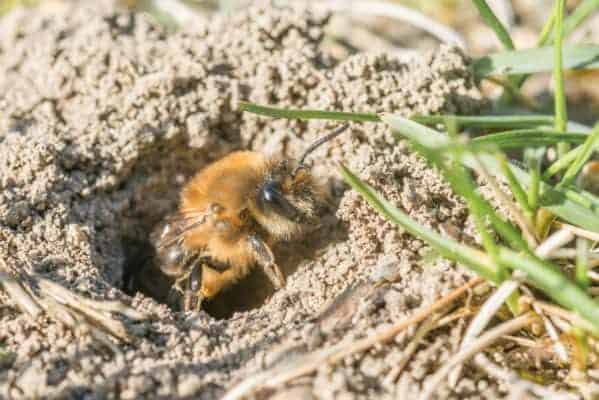
Mining bees are solitary bees. On occasions, lots of mining bees build their nests near each other, particularly if the ground has no obstacles. In some species, the females have single nest entrances with separate tunnels inside.
Mining bees dig holes about a quarter of an inch, and small excavated soil mounds encircle the holes. These bees prefer nesting in areas where there is scant plant life and like most solitary bees, spend their winter inside their nests.
Mining bees are potential pollinating agents for a variety of crops including tomato, cranberry, persimmon, blackberry, asparagus, raspberry, and clover.
Pollinator management techniques have not been developed for these bee species. However, mining bees show certain qualities (nesting in the same site for years, forage-plant generalist, non-defensive, gregarious nesters) that place them as ideal future study candidates (Noteable Bees, 2019). Since mining bees are good pollinators, controlling them is not recommended. Thankfully, they also do not often sting.
The Wrap Up
As we have seen carpenter bees get their names from their love for wood tunneling – not to eat the wood, but to excavate tunnels using their strong mandibles to build nests.
In nature, the preferred site for the nest is dead tree branches or tree stumps, but in urban areas, these bees can attack roof eaves, fence posts, porches (lanais), and railings.
In large colonies, these bees can be destructive. However, there are simple preventative measures that can be put in place to discourage carpenter bees from building nests in man-made structures that are not intended for such purposes.
Carpenter bees prefer unpainted and untreated wood materials. Applying sealers or painting fences and woods also make them less attractive to the nesting female carpenter bees.
Leaf-cutting bees and mining bees can be categorized as black bees due to their dark color, but they are not carpenter bees since they don’t drill on wood.
These two later black bees’ species face little conflict with humans since they mostly don’t have negative economic effects other than mild aggressiveness when handled.
There is a declining bee population globally due to diseases, pesticides, pests, malnutrition, and stress with local ecosystems requiring plant pollinators – and black bees are some of the best. With more than 500 carpenter bee species and a few other black bees species globally, each one plays an integral role in its local ecology.
Sources
Bees, N. (2019). My Blood Type Is Bees: Bee Notebook For Apiarists and Enthusiasts. Noteable Bees, Independently Published.
Wikipedia. (2020, September 4th). Carpenter bee. Retrieved September 4th, 2020, from Wikipedia
